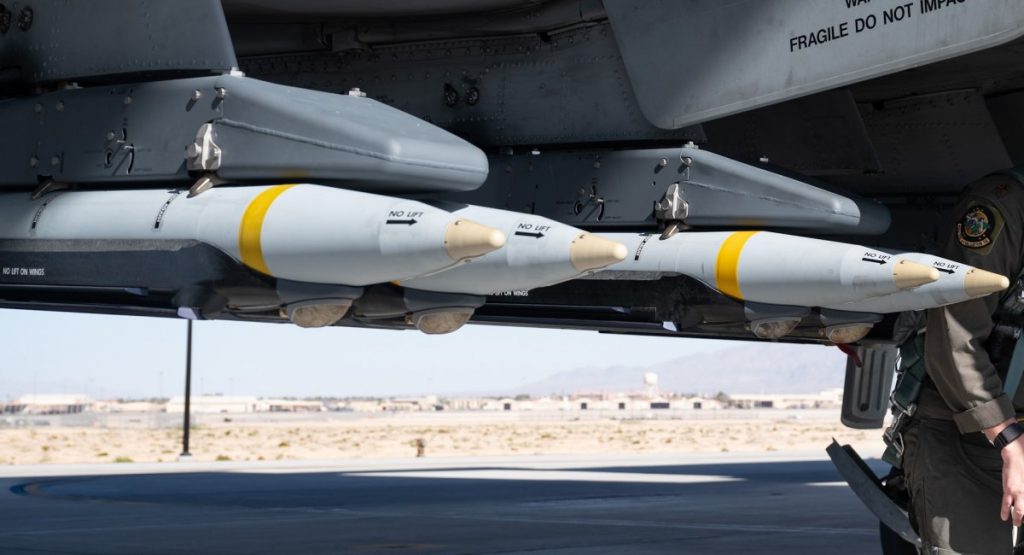Ukraine will receive bombs from Boeing: how they will help the Defence Forces
3 October 2024 19:45
The Boeing Company, the second largest manufacturer of precision weapons in the United States, has been awarded a multi-billion dollar contract for GBU-39 SDB-I bombs. Most of them will go to Ukraine. What is this weapon and how can it help the Defence Forces?
The GBU-39 is a small-diameter bomb. Its main task is to carry out precision surgical strikes, often in the vicinity of their troops.
That is why one of the modifications is made in a composite and carbon fibre body with a penetrating tungsten core to minimise shrapnel damage to friendly infantry nearby and to effectively use the product in urban combat. The kill zone is approximately 8 metres.
The warhead of the ammunition is small, 16 kg of explosive (in 155 mm shells this number is 10-11 kg), so jewellery precision is required – the product has a passport deviation of up to a metre, the bomb can literally be driven through a window and a dugout.
However, with its penetrating capabilities, a metre of concrete can be pierced by caponiers, and air detonation makes it possible to take out hidden manpower.
At 96kg, the aircraft can carry 4 SDB-1s on a single pylon, giving them targeting and communicating in the air via Link 16.
This provides tactical flexibility – a bunker can be hit, followed by engineering and fire trucks that arrive to clean up the aftermath, supporting the defenders right when new threats are identified (a platoon of tanks goes downhill and each receives a personalised gift).
The guidance head is combined – GPS, inertial system, and in the third iteration, the same laser used in GDAM.
This allows it to pass through areas of electronic warfare, weak satellite signals and accurately hit a moving target, including hard armoured targets.
Another noteworthy modification of the GBU-39 bomb is that it can be guided by a source of interference – working as an anti-radar missile or entering the area from which the conditional electronic warfare system “Zhitel” or “Leer” is emitting, it has a guidance head like the AGM-88 HARM, which will search for the equipment even after the signals from it stop.
According to open sources, the cost of a small-diameter bomb is approximately $45-50,000. The contract with the Ministry of Defence includes a sum of $430 million, most of which is from foreign military sales.
This means at least 7,500 units, the vast majority of which will go to Ukraine, with only a few dozen possibly going to Bulgaria.
The GBU-39 has a good track record – targets in Afghanistan, northern Iraq, Hamas bunkers in Gaza (it can be sold to Israel without congressional approval, which is usually required for foreign sales), ISIS pickup trucks in Mosul.
In Ukraine, it has been successfully used since the winter of 2023, integrated into Mig-29s (former Slovakian machines are seen in the photo, but most likely not only them, as the beam holder has been upgraded), for ground tracking. In this mode, it can fly up to 40 km. Tactical rear, tactical level command, warehouses, artillery, air defence of the Arrow and Wasp level.
Although 12 km is the maximum altitude at the speed of sound, a value of 112 km was achieved in testing conditions.
At the very least, with the help of electronic warfare, false targets and drones, you can image group targets and try to hit them as hard as possible to reach important targets in the depths.
But even at 40 km, it is effective because it is virtually invisible on post-Soviet radars, difficult to intercept by any air defence systems, can strike EW and passes through jamming zones on an inertial system, bringing the bomb to the target at the final stage of the trajectory with the help of a laser.
It is a tactically flexible weapon for direct air support (CAS). Fast reaction time, accuracy, penetrating head, aerial detonation – a “dagger” to poke a building garrison, suppress a heavy weapons crew, destroy a mortar or cannon, take out drone operators, knock out air defences.
A few thousand bombs, operational-level supplies that will make the lives of our infantry easier.
Author – Kyrylo Danylchenko









